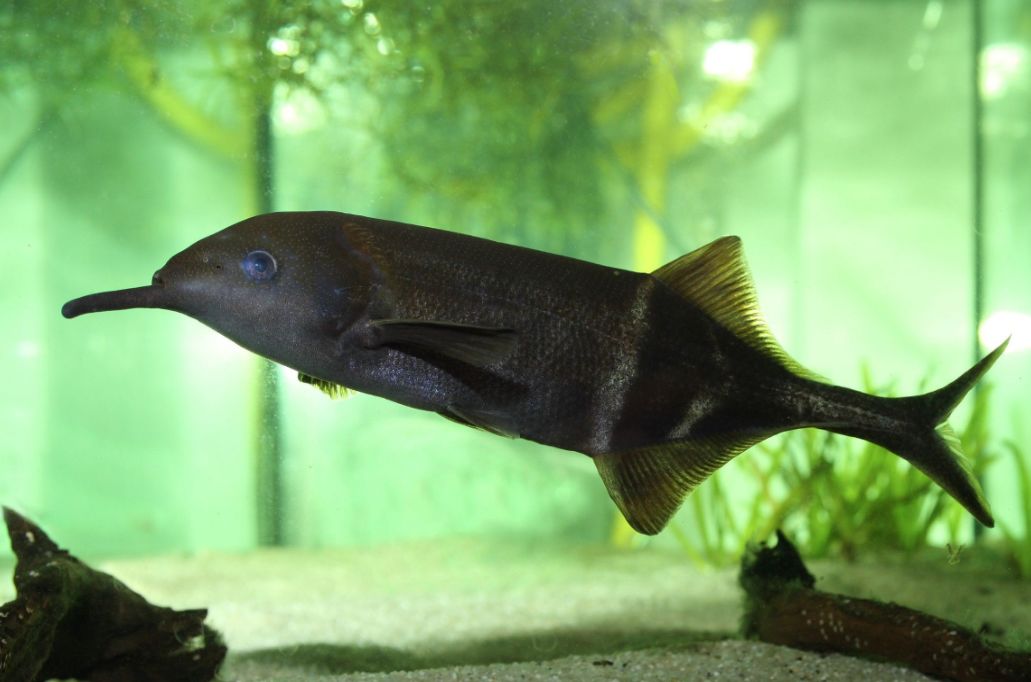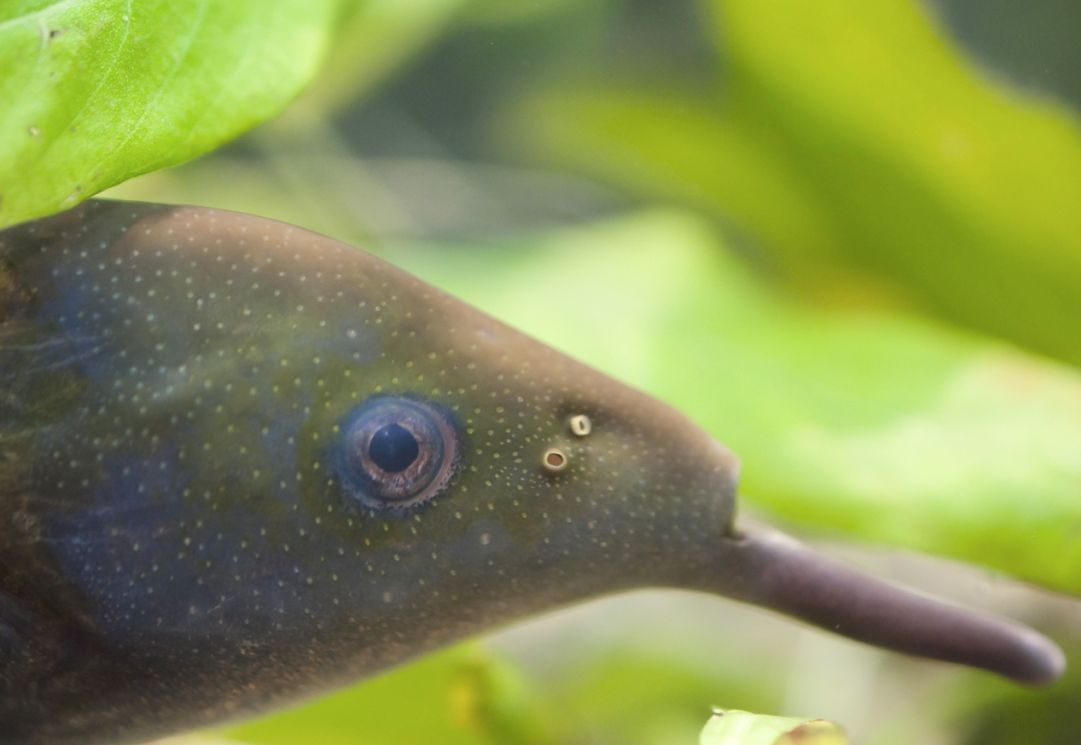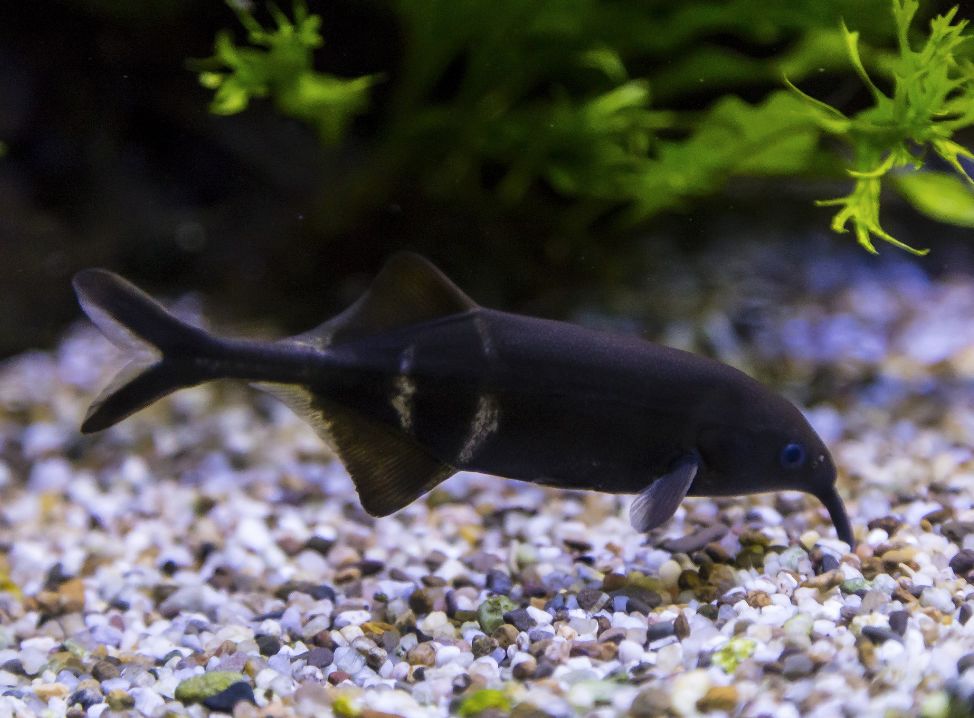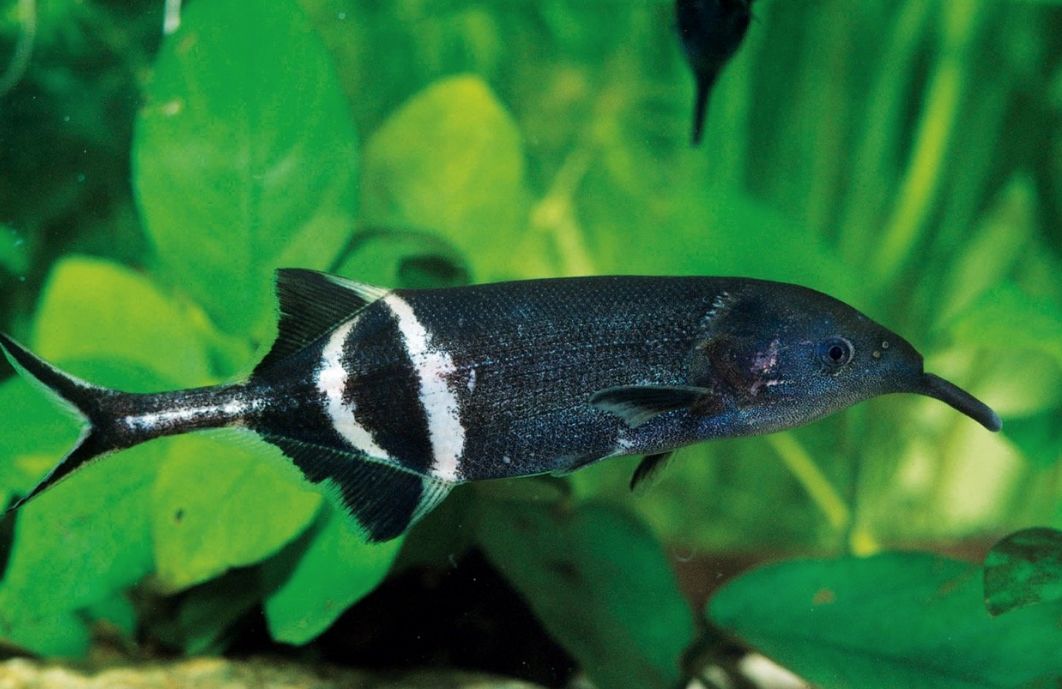If you’re an aquarium enthusiast looking to add a touch of intrigue and uniqueness to your aquatic collection, the elephant nose fish (Gnathonemus) presents an enticing option. With its mesmerizing appearance, intriguing behavior, and remarkable sensory abilities, this enigmatic freshwater species has captured the fascination of hobbyists and researchers alike. While challenging to maintain, keeping elephant nose fish in an aquarium provides a rewarding experience for those willing to provide the necessary care and attention.

Contents
Habitat in the wild
Elephant nose fish (lat. Gnathonemus petersii) is a freshwater fish species of Mormyridae family. The Mormyridae family consists of approximately 200 species of freshwater fish found in various regions of Africa. These fish are known for their unique ability to generate weak electric fields for navigation, communication, and locating prey.
The Mormyridae family showcases a wide range of sizes and appearances, with some species having elongated snouts resembling an elephant’s trunk, hence the common name “elephantfish.” These fish exhibit fascinating behaviors and adaptations that have attracted the interest of scientists and aquarium enthusiasts alike.
The fish got its specific name in honor of German zoologist Wilhelm Peters (1815—1883).
The elephant nose fish is widespread in central and western part of Central Africa, particularly in the Congo River Basin (Niger River, Ogun River and Chari River). It dwells in near bottom layer of muddy waters, prefers areas with slow water flow and thickly growing plants. These environments provide the necessary cover and food sources for their survival.
The elephant nose fish prefers areas with low light levels or areas where they can hide among plants and other structures. They are commonly found in habitats with submerged tree roots, submerged vegetation, and areas with floating plants. These aquatic plants and structures offer shelter, protection, and hunting grounds for the fish.
Their native waters often have soft, acidic to neutral pH levels, and the temperature ranges from around 75 to 82°F (24 to 28°C). The water conditions may vary slightly depending on the specific location and species of elephant nose fish.
Their natural habitats also include various microorganisms, invertebrates, and small prey items that serve as their food source. Elephant nose fish are known to feed on small insects, worms, crustaceans, and organic debris found in the waters.
This is a bottom-lying fish that lives near bottom and looks for food by means of the long protrusion on its head. Besides, the elephant nose fish has developed an unusual quality – this is a weak electric field by means of which it performs spatial navigation, looks for food and communicates with its relatives.
Description
How big do elephant nose fish get?
Elephant nose fish (Gnathonemus) typically reach lengths between 6 and 12 inches (15 to 30 cm). In the wild elephant nose fish can grow up to 30 cm long, but in captivity its size as a rule doesn’t exceed 25 cm (9.8 in).
The lifespan of elephant nose fish can vary depending on several factors, including their environment, care, and species. In general, elephant nose fish have a lifespan of around 8 to 10 years, although some individuals have been reported to live up to 15 years with proper care. As with any living creature, individual experiences may vary, and it’s important to provide optimal care and attention to ensure the best possible lifespan for your elephant nose fish.
It’s important to note that providing appropriate tank conditions, a balanced diet, and maintaining good water quality are essential factors in ensuring the longevity of elephant nose fish. Creating a suitable habitat that mimics their natural environment and addressing their specific needs can contribute to their overall health and lifespan.
The elephant nose fish possesses a unique and distinctive appearance that sets it apart from other freshwater fish species. The body is elongated and flattened from sides, with a streamlined profile that allows them to move swiftly through the water.
It doesn’t have abdominal fins, the pectoral ones are rear, dorsal and anal fins are symmetrically located almost near the forked caudal fin base. The place where the body joins with the tail fin is very thin.
The body coloring is dark-brown almost black and at certain lighting it can opalize with violet tint. Two light colored roundish arc-shaped lines connect dorsal and anal fins from both sides. Their coloration helps them blend into their natural habitats and provides some camouflage.
The elephant nose fish distinctive feature is its ‘mouth’ namely its ‘trunk-like’ underlip, that makes it look like an elephant. This organ has lots of nerve endings and can produce low electrical pulses that allow the fish to navigate in muddy water, find food, a partner and identify hazards.
| Characteristic | Description |
|---|---|
| Scientific Name | Gnathonemus |
| Common Names | Elephant nose fish, elephant fish |
| Family | Mormyridae |
| Native Habitat | Rivers and lakes of Central Africa, particularly Congo River Basin |
| Size | 6 to 12 inches (15 to 30 cm) in length, some species up to 20 inches (50 cm) |
| Body Shape | Slender and elongated |
| Snout | Elongated and trunk-like, resembling an elephant’s trunk |
| Coloration | Varies between species, typically shades of brown, gray, or black |
| Sensory Abilities | Electric organ for generating and detecting weak electric fields |
| Behavior | Nocturnal, social, and active swimmers |
| Preferred Water Parameters | Temperature: 75 to 82°F (24 to 28°C), soft to neutral pH levels |
| Feeding Habits | Omnivorous, feeding on small insects, worms, crustaceans, and organic debris |
| Compatibility | Generally peaceful, may require careful selection of tankmates |

Difficulties in keeping
The elephant nose fish is demanding in terms of keeping, since fish requires ideal water parameters and it is very sensitive to medicines and toxic substances content in the water. Besides, this is a timid fish, it becomes active in the evening and at night and it is demanding in terms of feeding.
When there are many fish species in a school they demonstrate more friendly and peaceful behavior provided with enough space and sufficient number of shelters in a tank.

Care and keeping in the tank
Tank size
For a single adult elephant nose fish, a minimum tank size of 30 gallons (113 liters) is generally recommended. This size allows the fish to have enough room to swim and explore their surroundings comfortably. However, it’s important to note that elephant nose fish are active swimmers and appreciate spacious environments. Therefore, if possible, providing a larger tank is highly beneficial. A tank with a length of at least 3 feet (91 cm) would be ideal, as it offers more room for the fish to move around and exhibit their natural behaviors.
It’s good to keep this fish in a school of at least 3-4 species, but it’s even better when there are 5-7 ones. In a large school the elephant nose fish feels more comfortable and tends to demonstrate aggression more seldom. Therefore, optimal number of the species in a school is 4-7, if you keep just two of them, then the alpha male may behave very aggressive continuing until death of the weaker fish.
So, if you plan to keep a group of elephant nose fish, it’s essential to provide even more space. A larger tank, such as a 55-gallon (208-liter) or 75-gallon (283-liter) tank, would be more appropriate to accommodate multiple individuals. The larger the fish school is, the larger should be the tank.
Remember, the tank size alone is not the only consideration for elephant nose fish. Creating a well-planted tank with hiding spots, appropriate water parameters, and suitable tank mates (if any) are also important factors in ensuring the well-being of these fish.
Tank decor
The elephant nose fish needs shelters, at that their number should be equal or exceed the number of species in a tank. Smooth stones, snags and tank plants that can live at the conditions of low lighting, such as anubias, fern of Microsorium kind – all these can serve as shelters.
In the wild this fish is active at night or in the evening, therefore it is important that the tank light is dim – the fish can’t stand bright light. Semidarkness, lots of shelters where the fish will stay during the day and come out sometimes to feed or to swim – there are all the conditions the fish requires. The tank should have a lid, since the fish may jump out of the water.
Substrate
Elephant nose fish are bottom-dwelling fish, and a sand or other soft substrate will do as the bottom one, otherwise the elephant nose fish may damage its trunk-like underlip which will make feeding it difficult. Sand provides a soft and natural substrate that allows them to exhibit their natural behaviors, such as sifting through the substrate for food.
If you prefer using gravel as a substrate, opt for smooth gravel without sharp edges. It should be small enough to prevent the fish from accidentally ingesting it. Smooth gravel allows for easy cleaning and helps to maintain good water flow within the tank.
Water parameters
Here are some recommended water parameters for these fish:
- The optimal temperature range for elephant nose fish is typically between 75 to 82°F (24 to 28°C).
- Elephant nose fish prefer slightly acidic to neutral water conditions. A pH level ranging from 6.5 to 7.5 is generally suitable for these fish. It’s important to monitor the pH regularly and make adjustments if necessary.
- Elephant nose fish generally prefer soft to moderately hard water. The ideal range for water hardness (GH) is typically between 4 to 10 dGH (degrees of General Hardness).
- Regular water testing is important to monitor ammonia, nitrite, and nitrate levels. The elephant nose fish is also sensitive to ammonia and nitrates content in the tank water considering that these tend to accumulate in the bottom substrate and the fish is a near bottom dweller.
The elephant nose fish is very sensitive to water composition change and because of this it’s not recommended for inexperienced aquarists as well as it can’t be kept in tanks where tank water parameters aren’t stable. Like other ganoid species, elephant nose fish is sensitive to most tank chemicals including salt.
Using powerful canister filter is a must as well as weekly water renew and cleaning the bottom substrate, you should also control ammonia and nitrates content in the water. Filtration and aeration are required, again the elephant nose fish is very sensitive to the water quality, one third of which you have to renew every week.

Diet
What do elephant nose fish eat? Elephant nose fish feeds mainly on insects and their larvae which it can find on the bottom. Small insects, such as mosquito larvae, water fleas, and small flies, form a significant part of their diet. They have a keen ability to detect and capture these small invertebrates. That’s why you should feed it first of all with bloodworm and tubifex. Some species can eat frozen and artificial food as well as well, but still you should give preference to live food.
You have to take into account the fact that elephant nose fish eats slowly, therefore don’t keep it together with fast and omnivorous species, because they can eat its food.
The fact, that the fish is trustful is particularly noteworthy, because in time you may train it to eat from your hands. One of the main criteria when feeding the elephant nose fish is that this is a nocturnal species and that’s why you should feed it either after you turn off the lights or shortly before this.
Tank mates
This is calm and peaceful, but territory depended species. It is compatible with almost any tropical species, however if there isn’t enough space intraspecific fights in the tank are inevitable. The elephant nose fish shouldn’t be kept with very active or aggressive tank mates, since it won’t be able to compete with them during the feeding process.
Here are some potential tank mates that can be suitable:
- Harlequin Rasboras (Trigonostigma heteromorpha)
- Neon Tetras (Paracheirodon innesi)
- Ember Tetras (Hyphessobrycon amandae)
- Glowlight Tetras (Hemigrammus erythrozonus)
- Black Neon Tetras (Hyphessobrycon herbertaxelrodi)
- Cardinal Tetras (Paracheirodon axelrodi)
- Rummy Nose Tetras (Hemigrammus rhodostomus)
- Dwarf Gouramis (Trichogaster lalius or Trichogaster chuna)
- Sparkling Gouramis (Trichopsis pumila)
- Celestial Pearl Danios (Danio margaritatus)
- White Cloud Mountain Minnows (Tanichthys albonubes)
- Dwarf Rasboras (Boraras spp.)
- Endler’s Livebearers (Poecilia wingei)
- Guppies (Poecilia reticulata)
- Platies (Xiphophorus spp.)
- Corydoras Catfish (Corydoras spp. – pygmy cory, panda cory, adolfoi catfish)
- Otocinclus Catfish (Otocinclus spp.)
- Bristlenose Plecos (Ancistrus spp.)
Gender differences: male vs female
It is unknown how to tell between the male and female. They have quite little pronounced dimorphism. It is considered that elephant nose fish females are larger and they have more rounded abdomen.
In most cases, the only reliable method to determine the sex of elephant nose fish is through internal examination. This involves examining the fish’s reproductive organs, which can be invasive and require the expertise of a trained professional or a veterinarian experienced in fish anatomy.
Therefore, for practical purposes in a home aquarium, it is generally not feasible or necessary to distinguish between male and female elephant nose fish. They can be kept and cared for without the need for sex differentiation.
Breeding
For now there had been no recorded successful cases of breeding in a tank. Therefore this fish isn’t bred in captivity and all the species you see on sale were caught in the wild.